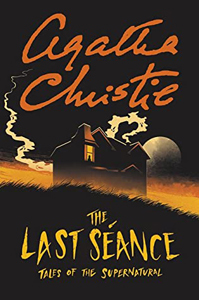Agatha Christie was fascinated by the supernatural and paranormal – or at least the possibility thereof. But because her genre short stories are peppered across various collections, they’re always surprising. That’s a good thing – it gives us a little extra jolt.
But there’s something to be said about gathering most of her supernatural tales in one place, which “The Last Séance: Tales of the Supernatural” did upon its 2019 publication. (One can quibble that the Harley Quin yarns aren’t here, but most of those are in “The Mysterious Mr. Quin.” And anyway, the verdict is still out on whether he’s supernatural. Christie goes right up to the cliff’s edge of rational explanation for his activities.)
Reading these 20 stories in one volume underscores not only Christie’s prolific nature in the horror genre, but also her contribution to tropes. Plus, she’s pretty decent at spinning a spine-tingler.

“The Last Séance: Tales of the Supernatural” (2019)
Author: Agatha Christie
Genre: Horror, mystery short stories
Settings: England (usually), from 1922 through 1958
Note: Except for “The Wife of the Kenite,” these stories appeared in previous collections.
Another effect of reading these stories together: It’s like watching “The X-Files” (or “Evil,” to cite a current TV show). The answer could be supernatural or it could be natural. But if Mulder and Scully investigated these cases, the script would be flipped: Scully would more often be correct.
I’ll go through “The Last Séance” in the order of when these stories first appeared in U.S. collections. So if you don’t have this new publication, you can put together your own reading experience by pulling from your bookshelf (except for the newly published “The Wife of the Kenite”).
I like to point out cases where they parallel popular horror films and TV, so I must institute a SPOILER WARNING. Reader beware.
Not previously published in U.S.
“The Wife of the Kenite,” published in an Australian magazine in 1922 but nowhere else until a 2018 U.K. printing, is characteristic of many of Christie’s horror yarns in that it could be supernatural or coincidental. It’s also one of her most brutal pieces as she describes a German war atrocity and a mother’s thirst for revenge. This ain’t no cozy village mystery.
War flashbacks feature in many horror movies; a pair of examples are the “Exorcist” prequels.
From ‘Poirot Investigates’ (1924)
The first spooky-tinged yarn most Christie fans will encounter if they’re perusing the bookshelf in chronological order is “The Egyptian Tomb” (1923). It’s the most memorable entry in this tame collection, as Poirot cleverly uses people’s credulity against them.
A regular vacationer in the Middle East, Christie would return to the area for many stories, including the spooky novels “Appointment with Death” and “Death Comes as the End.” The Middle East memorably features in, again, the “Exorcist” franchise.
From ‘The Tuesday Club Murders’ (1933)
Miss Marple plays a debunker who would make Scully proud in two tales from the volume where she’s knitting in her armchair while solving mysteries dictated to her. “The Idol House of Astarte” (1928) moodily calls to mind the Forbidden Forest of the “Harry Potter” books and films. That’s what I pictured in my head as the location of the murder.
“The Blue Geranium” (1929) is a brain-teaser where Marple finds the rational reason for why wallpaper changes colors on its own. Gaudy wallpaper is often a backdrop in 1970s horror flicks, plus newly minted period pieces like the “Conjuring” films. Christie takes the cake, though, in making wallpaper central to a story.
From ‘The Regatta Mystery and Other Stories’ (1939)
“In a Glass Darkly” (1934) is a scary-sweet romance about a man who thinks he sees a terrible future in a mirror. Interested in the fact that mirrors give a reverse image, Christie liked to use them in her non-supernatural works; a mirror factors into “Dumb Witness” and “Funerals are Fatal.”
Mirrors are staples of horror films, with that always effective cliché of someone seeing a ghost behind them. Then they turn around and it isn’t there; instead, it was only in the mirror. The “Candyman” saga, which recently released its fourth film, makes the most robust use of the idea of the mirror holding another world.
In “The Dream” (1938), a man tells Poirot he keeps dreaming of his own suicide. Of course, dreams (usually of the bad variety) factor into lots of horror, most famously the “Nightmare on Elm Street” saga, and more recently “Malignant.”
From ‘The Labours of Hercules’ (1947)
“The Flock of Geryon” (1940) is a rare case of religious creepiness from Christie, as Poirot encourages his charge to gather evidence against a cult leader who is killing and defrauding lonely women. Although much lighter, “Flock” broadly resembles the likes of daylight horror classics “The Wicker Man” and “Midsommar,” and Mike Flanagan’s recent church-based miniseries “Midnight Mass.”
From ‘Witness for the Prosecution and Other Stories’ (1948)
The most famous story other than the titular entry, “Philomel Cottage” (1924) is like a softer version of “The Shining” as it chronicles a woman stuck in a house as her husband gradually loses his mind.
The golf course-set “The Mystery of the Blue Jar” (1924) is an excellent example of Christie telling a scary story – the player hears a scream every time he plays a certain hole – even though the answer turns out to be rational.
“The Fourth Man” (1925) plays out in a train cabin like in the opening of “Harry Potter and the Prisoner of Azkaban,” where Professor Lupin is a mysterious “fourth man” who fends off a Dementor. It also deals with possession, a common trope found in any film with “Exorcist,” “Exorcism” or “Possession” in the title.
Modes of communication feature in the titles of three shorts in this volume. In “The Red Signal” (1924), a medium senses danger is afoot. TV’s “Medium” used extrasensory abilities to solve crimes, while the “Insidious” pictures are a scarier example.
“S.O.S” (1926) involves the Christie staple of poisonings, but in a creative way. And in “Wireless” (1926), a woman hears the voice of her deceased husband through the radio. The second “Conjuring” film is a strong example of a flick featuring voices from the beyond.
From ‘Double Sin and Other Stories’ (1961)
“The Last Séance” (1926) is a bizarrely straightforward – and violent — story of a medium performing one last séance before she gives up the practice because it’s so physically exhausting. Since there’s no twist ending, I’m guessing the very idea of someone who serves as a link to the great beyond was shocking enough in 1926. This story is notable for being unequivocally supernatural – a rare point for the Mulders out there.
“The Dressmaker’s Doll” (1958) is the only horror story Christie wrote in the century’s latter half, and it’s my favorite of her genre works. It’s firmly in line with scary-doll movies like “Annabelle” and “The Boy.”
The author hits on why dolls can quickly shift from amusing to scary. Women in a boarding house let the doll take over a room so they don’t have to deal with her antics (which simply involve moving from one spot to another). The moral-based twist ending is brilliant, and one that hasn’t been repeated in recent scary-doll flicks.
From ‘The Golden Ball and Other Stories’ (1971)
All five shorts from this collection were written in 1933, the heyday Christie’s genre shorts.
“The Call of Wings” – about a man thirsting for meaning beyond materialism — actually calls to mind “It’s a Wonderful Life” but with a darker hand of fate. “The Gipsy” likewise touches on fate and fatalism as we imagine people finally finding happiness in the afterlife. Flanagan’s “The Haunting of Hill House” and “The Haunting of Bly Manor” tap into this vibe.
Speaking of the afterlife, “The Lamp” is a classic tale of a lonely child playing with his new ghost friend in a haunted house. Take your pick of modern examples; I’ll go with the underrated “Darkness” (2002).
“The Strange Case of Sir Arthur Carmichael” is an entertaining if predictable story of a man who acquires the traits of a cat. Transmogrification stories today most often feature werewolves; see “Teen Wolf” and, again, “Harry Potter’s” Lupin.
Finally, “The Hound of Death” combines the inexplicable with rigorous observation in a fascinating mad-scientist tale in the tradition of “Frankenstein.” So, in a final twist, I’m citing a parallel from a century before Christie’s tale.
But even here, Christie is an original thinker. Respected authors since her time – like Michael Crichton in “Travels” (1988) – have posited that the paranormal is simply things we can’t yet explain and codify. Science will get there someday.
But hopefully not too soon. It’s fun to get creeped out.
Every week, Sleuthing Sunday reviews an Agatha Christie book or adaptation. Click here to visit our Agatha Christie Zone.


